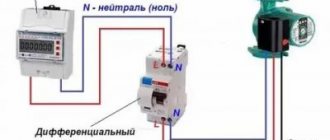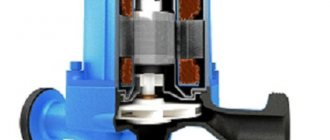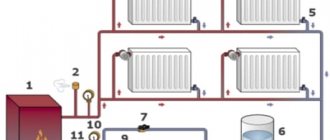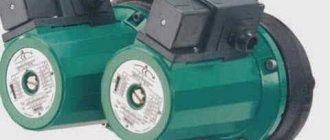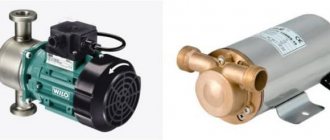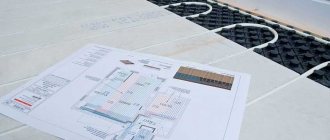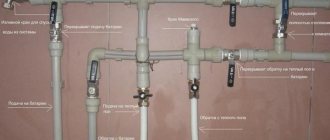Pump selection according to technical specifications
Typically, circulation pumps, such as in the photo, are used for floor heating designs. The characteristics of these units best meet the requirements for them.
You should know how to calculate the pump power for a heated floor correctly in order to purchase the right model.
Calculations are made according to the formula:
Q = 0.86×Pн/(t°flow t – t°rev.t), where
Q – liquid consumption in cubic meters per hour;
Pn – maximum circuit power (kW);
t°pr. t – value of water temperature in the supply pipe;
t°rev. t is the temperature of the liquid at the outlet.
If, when laying a structure, the installation of several circuits is planned, then you need to find out the total value taking into account each of them.
According to experts, it is better to equip a separate room with an autonomous heating system for the floor surface, as a result of which it becomes possible to use thermal energy economically. It will be possible to regulate the state of the microclimate depending on the purpose of a particular room, and make the operation of the structure more reliable.
The difference between the temperature of water in the heating circuit at its inlet and outlet depends on a number of parameters:
- Pipeline length
. The longer the circuit, the larger the area it must heat. This means a significant consumption of thermal energy, and the inlet and outlet temperatures will be very different; - The quality of thermal insulation
. If the technology was violated during the creation of the system, then heat losses during the operation of the heated floor will reach high figures. This is especially true for rooms located on the ground floor, since improperly made thermal insulation will contribute to the consumption of a significant amount of energy for heating the ground. Excessive heat loss leads to an increase in the load placed on the circulation pump for the heated floor. - Climate in the area where the house is located
. The further north the region, the greater the power reserve the heating system and circulation unit should have. Manufacturers advise choosing them with an indicator of 20–25%.
Another important value for determining how to choose a circulation pump for a heated floor is the pressure of the coolant flow. It should be enough to overcome the hydraulic resistance of the water in the system. The hydraulic resistance indicator depends on the length of the circuit, the cross-section of the water pipes, and the speed of movement of the liquid.
When purchasing a pump, you should pay attention to the fact that the above parameters are indicated in the accompanying documents.
When independently arranging the system, the formula is used to calculate the coolant pressure:
H= (П×L + ΣК) /(1000), where
H is the desired value;
P – hydraulic resistance per meter of circuit;
L – length of the longest of the circuits together with control systems;
K is the coefficient of the recommended power reserve of the device.
After all the data becomes known, they move on to choosing the optimal pump model.
Calculation of pump parameters
Circulation pumps are installed in heating systems. They do not create excess pressure, but simply push the coolant at a certain speed. Since the need for heat changes depending on weather conditions, the speed of movement of the coolant must also change. Therefore, it is better to install adjustable pumps - three-speed.
Before purchasing, you should decide on two main parameters: performance (flow) and pressure. If the coolant is water, the pump performance is calculated using the following formula:
Q = 0.86*Pn/(trev.t - trev.t)
- Pн — heating circuit power, kW;
- trev.t - temperature of the coolant in the return
- tpr.t — supply temperature.
The temperature difference in water heating systems is usually 5 ° C, the power of the circuit most often depends on the heated area, therefore, to simplify the selection of a pump for a water heated floor, you can use the table. But it must be taken into account that the calculations took average figures for central Russia. Therefore, if your house is not well insulated, or you live significantly north or south of the middle zone, you will have to adjust the result (or calculate it yourself). In general, this parameter is taken with a margin of 15-20% in case of abnormal cold weather.
Table for determining pump performance depending on the heated area
The second characteristic by which a pump is selected is the pressure it can create. Pressure is necessary to overcome the hydraulic resistance of pipes, fittings, and other system components. The system resistance depends on the pipe material and its diameter. The value of the hydraulic resistance of the pipe is available in the accompanying documents (averaged data can be used). Also taken into account is the increase in resistance on the valve (1.7), on the fittings and fittings (1.2) and on the mixing unit (required when using a high-temperature boiler and the coefficient for it is 1.3).
H= (П*L + ΣК) /(1000),
- H—pump pressure;
- P is the hydraulic resistance of a linear meter of pipe,
- Pa/m; L is the length of the pipes of the longest circuit, m;
- K is the power reserve factor.
To calculate the required pressure in the circuit, the nameplate hydraulic resistance of a meter of pipe is multiplied by the length of the circuit. The value is obtained in kPa (kilopascals). Convert this value to atmospheres (pump pressure is measured in atmospheres) 100 kPa = 0.1 atm. The found value, depending on the presence of fittings and valves, is multiplied by the corresponding coefficients. After all the operations, you have found the operating point of the pump.
Select a model based on graphic characteristics
But the calculation of the pump for the heated floor is not finished yet. Now you need to select a model. To do this, find the characteristics of the pump in the catalog of the manufacturer you like. It is presented in the form of a graph. Select the model so that the found operating point is in the middle third of the characteristic. If you are installing a three-speed option, then select a model with the second speed - this will ensure an optimal, and not at the limit, operating mode and your pump will last a long time and provide a normal temperature even on cold days.
Pumps equipped with a “wet” rotor
The external dimensions of such devices are minimized due to the location of the impeller close to the pump rotor; sometimes it is located in the same housing. To prevent liquid from entering the electric motor, a reliable oil seal made of wear-resistant and heavy-duty rubber is installed on the drive shaft.
Sometimes double water protection is provided for the circulation pump. Since the unit is compact in size, it can be installed directly in the room that will be heated. Manufacturers guarantee power that is enough to operate a heating structure over an area of up to 400 square meters.
Marking and case material
These are two or three numbers like: 25/40, 25/60-130 or 32/80, etc. The first number is the diameters of the inlet/outlet holes in millimeters. That is, in the given markings the connecting dimensions are 25 mm and 32 mm. The second number is the lifting height that this model provides. In the example given, these are 4 meters, 6 meters and 8 meters. If we translate atmospheres, then this is 0.4 atm, 0.6 atm, 0.8 atm. The third number is the installation length, that is, the size of the entire device from one end to the other. In our example it is 130 mm.
Pumps equipped with a dry rotor
For such devices, all elements are located in a separate housing. Sufficiently powerful hydraulic units are capable of serving large apartments or several at the same time. To accommodate devices with a “dry” rotor, it is necessary to allocate a technological room. They are installed on a separate frame.
Such pumps have significant weight, and the high levels of noise emitted do not allow them to be placed in living rooms. They are rarely used for private households. Water pumps with a dry rotor are used for large areas - industrial and commercial.
They are driven by a three-phase motor. The pumps are equipped with a complete protective kit for electrical components.
Information on the pump housing
The standard markings applied to the body must contain all the technical parameters of the unit. The first number on top indicates the mounting diameter of the pipes for the coolant, the second indicates the pressure (meaning the maximum rise of the liquid to a height), the third number indicates the length of the pump in operating condition.
The following indicators indicate the voltage and frequency of oscillations in the network. Then comes information regarding the magnitude of the phase shift coefficient. The body may contain data on the height of liquid rise depending on the cross-section of the pipes.
Some of the units are equipped with two engines. This design feature allows you to overcome peak loads without overheating the windings. The second of them is put into operation, which is also capable of replacing the failed first engine. As a result, the possibility of the structure freezing in severe frosts is eliminated.
Pump installation features
Heating engineers have developed rules that must be followed when installing pumps in a heated floor system:
- When installing a circular pump into the circuit, the rotor is positioned horizontally. Compared to a vertical arrangement, this arrangement saves 30% of engine power.
- More often, the pump is installed in the supply pipeline, but after the mixer. Although, other options are not excluded.
- Half of the pumps are equipped with a release valve. It is located on the front panel. It is a disk with a slot. After filling the coolant, but before connecting the pump to the network, turn the disk with a screwdriver and bleed air from the housing. If this is not done, the pump will fail, or the air lock will not allow the coolant to circulate freely through the pipeline.
Electric pump installation options
Circulation units are allowed to be installed both at the inlet and outlet of liquid from the pipeline. The installation location is usually selected based on the characteristics of the circuit.
At the water outlet, its temperature is much lower than at the inlet, which is preferable for pumps. But installation at the end of the circuit is not mandatory, since all units are manufactured with a certain margin of safety relative to the maximum operating temperature conditions.
Selecting a pump for a water floor system
Many owners of private households planning to install a floor heating system are interested in the question: “How to choose a circulation pump for a heated floor?”
Experts advise purchasing pumps at the same time as the structural elements of the “warm” floor. Attempts to independently purchase a unit may result in a decrease in the efficiency of the system or its rapid failure. As for the repair of the “warm” floor, it will cost a significant amount.
However, if this is not possible, then knowing how to calculate a pump for a heated floor and how to choose it wisely, you can choose the right model.
Where is the best place to put the pump?
In conventional heating systems, the circulation pump is placed exclusively on the return line, directly in front of the boiler. But in the case of heated floors, this option is far from the best.
The pump connection diagram provides for the installation of pumping equipment on the coolant supply. This is due to the peculiarities of the operation and operation of the water circuit.
Violations of the tightness of threaded connections, the presence of differences in the height of the pipe laid in the floor, malfunctions of the heating system - lead to the appearance of air locks. The pump is set to supply to prevent airing of the system as much as possible and, if necessary, squeeze out air. {banner_downtext} Other options for connecting the pump also exist. But as practice shows, if you start a pump that is supplying coolant, you can achieve better results.
Recommendations from experts
To extend the life of the pump, you must remember the following rules:
- The unit must be installed in a place where, if necessary, repair work or warranty service can be carried out without problems.
- Despite the fact that imported pumps are of high quality, before the start of the heating season it is necessary to check their technical condition due to the low quality of water and the peculiarities of operating conditions. Particular care should be taken to inspect the condition of the oil seal, which ensures waterproofing of the device shaft from the rotor.
On the eve of the start-up of the floor heating system, it is necessary to remove any air pockets in it. For this purpose, the water is changed several times and a special valve is installed. The presence of air pockets will become an obstacle to the movement of liquid, and the automation will constantly begin to turn on the circulation.
Trouble-shooting
The main factor that negatively affects the functioning of the pump is the quality of the water entering the water heating circuit. If the pump operates continuously, salt deposits reduce its performance to a lesser extent than during periods of shutdown.
Connection diagram of the circulation pump to the electrical network
Sometimes, after turning off the heated floor for the summer period, the next time it is turned on, the pump stops pumping water due to the fact that the rotor does not turn. You need to carefully turn the impeller several times using available tools. If the pump does not start to function, professional help will be required.


